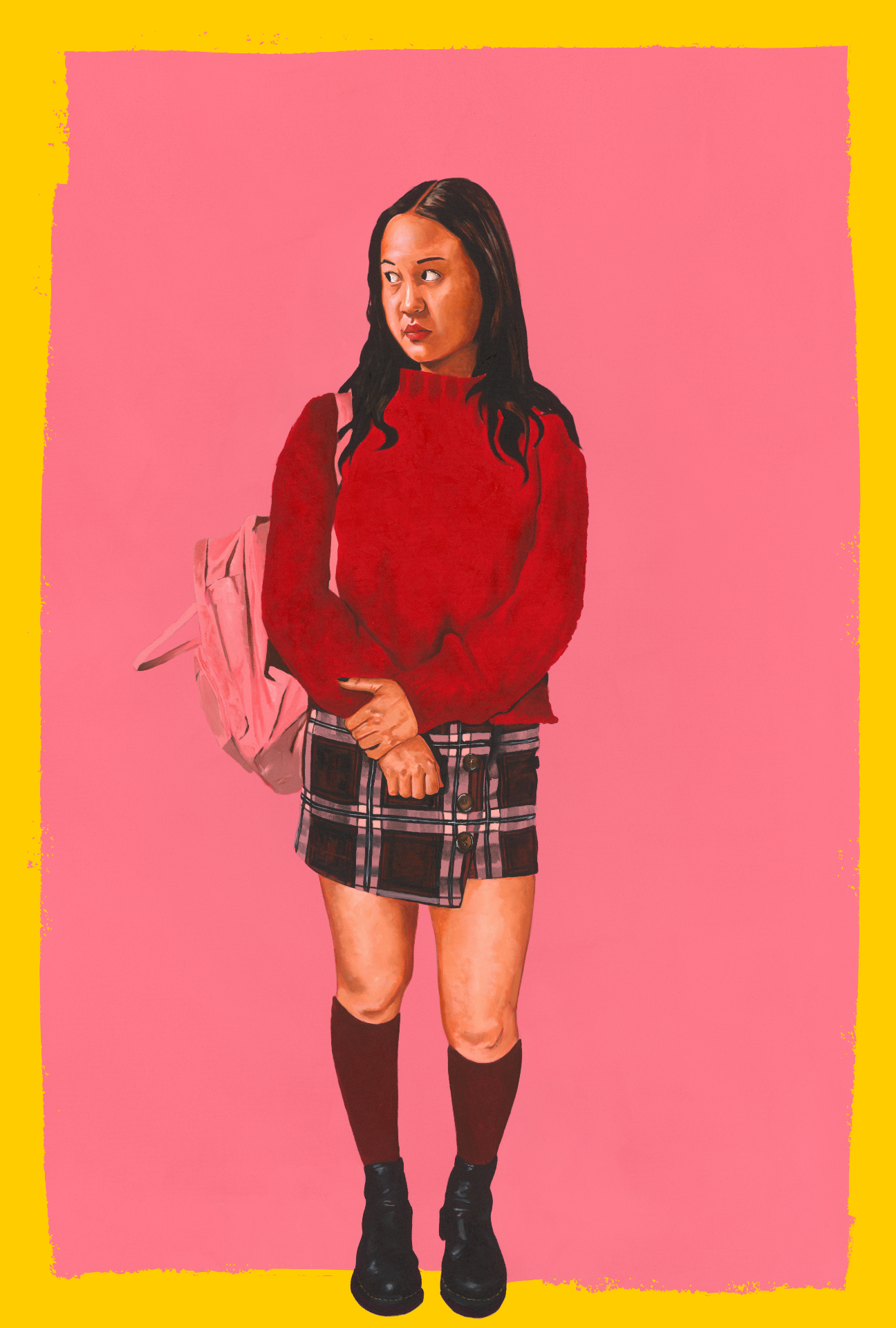Last week, Netflix premiered its latest coming-of-age drama, Grand Army, about a group of high school students in Brooklyn, NY trying to find their way through the struggles of adolescence. Besides the timely subject matter, the series caught many people’s eye due to its striking poster art. The man responsible for capturing both the personality and angst of the lead characters consisting of Dom, Sidd, Joey, Jayson, and Leila in vivid color is visual artist Dr. Fahamu Pecou.
World renowned artist and New York native, Dr. Pecou, whose work overlays social commentary and hip-hop culture onto contemporary art, was the perfect person to bring Grand Army’s dynamic characters to life. Not only are his pieces known for forcing people to revisit their ideas about racial stigmas surrounding Black men in America and the impact media has on those stereotypes, but he’s also a professor of media at Morehouse College in Atlanta, GA. Drawing inspiration from his own personal experiences growing up in Brooklyn, Dr. Pecou painted the characters of Grand Army in a way that not only captured their true essence but helped build hype for the dramatic series. We caught up with Dr. Pecou to get insight into his creative process, the power of color, and his connection to each character.
Grand Army is now streaming on Netflix.
Complex: In the past, you’ve said that art is often used to tell a story. What stories do you try to tell with your art?
Dr. Pecou: My art attempts to tell the story of Black masculine identities. Oftentimes, we as Black men are forced into very restricted boxes and ideas around who we are supposed to be and how we're supposed to be. I try to explore the stereotypes around Black masculinity, and actually get inside of them as a way of opening [the stereotypes] up and explode them from the inside out.
That’s no easy feat. How do you go about taking on such an undertaking?
I teach a course at Morehouse [College] on the constructions of Black masculinity in the media. We're currently reading this text by Professor Mark Anthony Neal called Looking for Leroy. The subtitle is Illegible Black Masculinities. The text makes a distinction between the constructions of Black masculine identity that we've come to know in the media, and the ways that certain characters that we might see in television shows, or maybe even hip-hop artists, slip in between the borders of those constructions. They ultimately become illegible. I'm actually trying to render Black masculinity illegible from the constructs that have been projected onto us.
“When you look at one of my paintings, I want you to walk away with as many questions as you approached it with... I’m encouraging you to think.”
How do you think that storytelling is seen in visual art versus any other creative medium?
Oftentimes we might watch a film or read a book and we're looking for a resolution. We have a beginning, middle and end, and we're looking forward to being wrapped up in the end with some kind of tidy bow that we can walk away from and feel like, That's done. When you look at one of my paintings, I want you to walk away with as many questions as you approached it with, because ultimately as you walk away with those questions, now your mind is working. I’m encouraging you to think.
What did you want people to think about when they look at your paintings of the Grand Army cast?

I had the opportunity to read through the scripts and to see some early test cuts of the series. It gave me an opportunity to really get intimately engaged with the characters, and I tried to bring that sense of intimacy to the portraits I created. One of the things that's really interesting about each and every one of the characters in the series is [the notion] around illegibility. At a certain point, you feel like you have a grasp on who the characters are as individuals, but there's always something beneath the surface; something bubbling in the background that you're not aware of until it blows up in your face. It really makes the characters in the series extremely dynamic because you can't pin them down.
What’s the significance of color in your art?
I'm not going to pretend to be a color theorist by any stretch of the imagination, but I do have some working knowledge of the way color works psychologically and how color convinces us of certain ideas. And so what I try to do is do a little bit of research around specific qualities that are associated with different colors and try to apply those to the qualities and portrayals of the characters in the series.
How did you decide which colors to use for each of the Grand Army characters?
When you meet Dom, you see her as this kind of tough exterior, Haitian-American girl in Brooklyn. But behind the surface, there's this really pure, and powerful, and radiant being. The color that I chose for her was yellow. Yellow is a color that denotes courage, light, and brilliance. The color that I chose for Joey was red because she is fiery, strong, and powerful. The same thing with Leila, with the color pink. We often think of pink as being something soft, but pink can also be treacherous.
Which character’s story resonated with you the most?
Dom’s Caribbean heritage was something that I connected with. My whole family is Panamanian, and I also grew up in the projects. I understood the idea of having to look out and take care of other people in your family—sometimes at the sacrifice of your own wellbeing.
We often think about Black boys as problematic or [enduring] some kind of trauma. With Jayson...I wanted to give us something different to think about.
Do you think teenagers today are facing the same types of issues you faced growing up or are they facing a completely new set of problems?
I think it's relative, but the world that we live in is a very different world than when I was 16. When I was 16 years old, the most long distance relationship I had was with a friend who lived on the other side of town. Now, the Internet has allowed our world to shrink and that has changed the dynamics of how people see themselves.
How so?
When I was growing up, that sense of gratification could be fulfilled by making a good grade on my test. Now it's like, Dang, I only have 50 likes on this post that I put up eight hours ago. Did I do something wrong? I think the anxiety is heightened. Grand Army literally made me go sit down with my daughter and ask, Are you okay? Is everything good?
Racial stereotypes are at the forefront of today’s conversations. What stereotypes do you see in the characters that you wanted to bring to life, and how would you want those to be perceived differently?
We often think about Black boys as problematic or [enduring] some kind of trauma. With Jayson, his portrait looks thoughtful. He's sitting with his hat on the stairs, and he doesn't look like he might be up to no good. I didn't want to render him in that way. I wanted to give us something different to think about.

